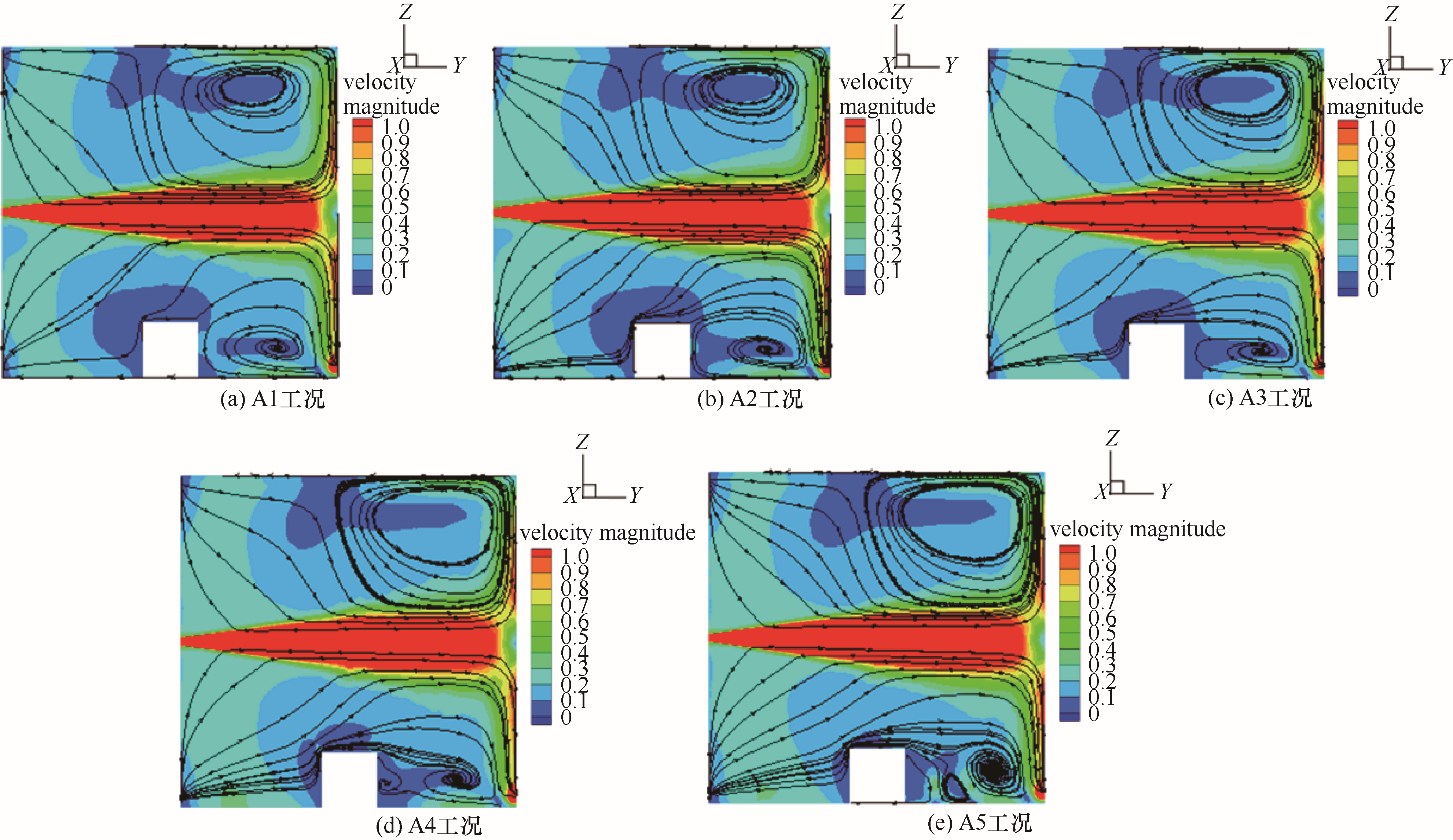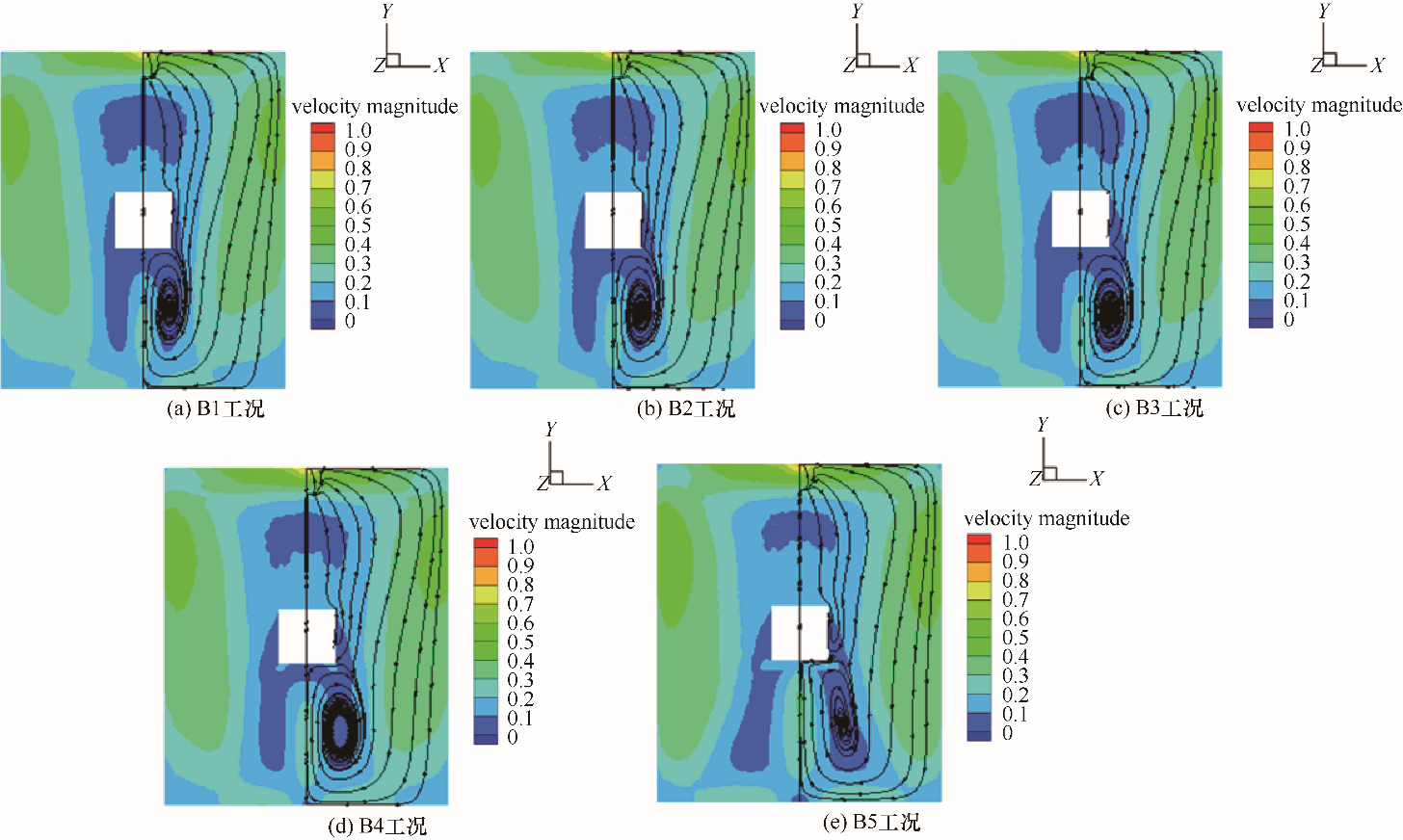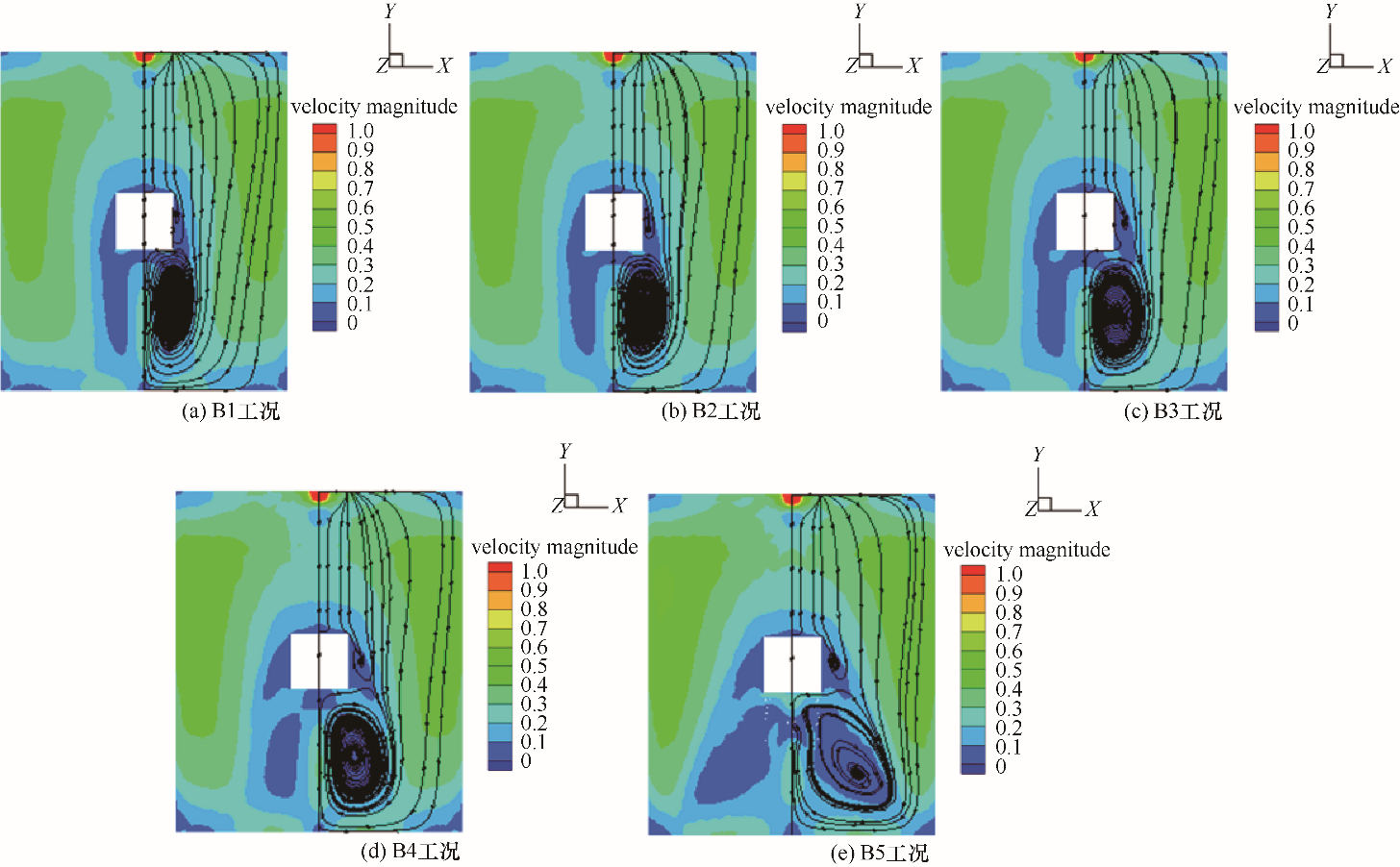化工学报 ›› 2020, Vol. 71 ›› Issue (S1): 57-67.DOI: 10.11949/0438-1157.20191163
收稿日期:2019-10-10
修回日期:2019-10-20
出版日期:2020-04-25
发布日期:2020-04-25
通讯作者:
张旭
作者简介:张倩茹(1990—),女,博士研究生,基金资助:
Qianru ZHANG( ),Xu ZHANG(
),Xu ZHANG( ),Wei YE,Chengqiang ZHI,Yixiang HUANG,Wenxuan ZHAO,Jun GAO
),Wei YE,Chengqiang ZHI,Yixiang HUANG,Wenxuan ZHAO,Jun GAO
Received:2019-10-10
Revised:2019-10-20
Online:2020-04-25
Published:2020-04-25
Contact:
Xu ZHANG
摘要:
在实际的工业场景中,机器设备等障碍物的存在对污染物的扩散及分布有着很重要的影响。考虑了在有障碍物的大空间中,泄漏位置在障碍物两侧的场景。定义了污染源重力作用强度指标、无量纲浓度以及易燃易爆区域占比。用实验验证了计算流体力学(CFD)模型的准确性,进而用CFD计算了不同污染物释放速率时的速度场及浓度场。计算结果表明,随着污染物释放速率的增加,速度场的结构和浓度场的分布形式都发生变化。当无量纲数θinlet超过0.0288时,污染源附近会出现新的涡流,而无量纲浓度分布开始出现垂直分层的趋势。当污染源体积释放速率超过2.66667×10-5 m3/s时易燃易爆区域的大小变得显著,导致潜在的爆炸风险。
中图分类号:
张倩茹, 张旭, 叶蔚, 职承强, 黄奕翔, 赵文萱, 高军. 大空间重气泄漏下速度场、浓度场特性分析[J]. 化工学报, 2020, 71(S1): 57-67.
Qianru ZHANG, Xu ZHANG, Wei YE, Chengqiang ZHI, Yixiang HUANG, Wenxuan ZHAO, Jun GAO. Analysis of velocity and concentration field characteristics of heavy gas leakage in large space[J]. CIESC Journal, 2020, 71(S1): 57-67.
| 工况名称 | 换气次数/h-1 | 污染源位置/m | 污染源释放强度/ (kg/(m3·s)) |
|---|---|---|---|
| A1 | 3 | (0,4,0.5) | 1 |
| A2 | 3 | (0,4,0.5) | 5 |
| A3 | 3 | (0,4,0.5) | 10 |
| A4 | 3 | (0,4,0.5) | 20 |
| A5 | 3 | (0,4,0.5) | 50 |
| B1 | 3 | (0,2,0.5) | 1 |
| B2 | 3 | (0,2,0.5) | 5 |
| B3 | 3 | (0,2,0.5) | 10 |
| B4 | 3 | (0,2,0.5) | 20 |
| B5 | 3 | (0,2,0.5) | 50 |
表1 模拟工况
Table 1 Simulation configurations
| 工况名称 | 换气次数/h-1 | 污染源位置/m | 污染源释放强度/ (kg/(m3·s)) |
|---|---|---|---|
| A1 | 3 | (0,4,0.5) | 1 |
| A2 | 3 | (0,4,0.5) | 5 |
| A3 | 3 | (0,4,0.5) | 10 |
| A4 | 3 | (0,4,0.5) | 20 |
| A5 | 3 | (0,4,0.5) | 50 |
| B1 | 3 | (0,2,0.5) | 1 |
| B2 | 3 | (0,2,0.5) | 5 |
| B3 | 3 | (0,2,0.5) | 10 |
| B4 | 3 | (0,2,0.5) | 20 |
| B5 | 3 | (0,2,0.5) | 50 |
| 污染源释放强度/(kg/(m3·s)) | θinlet |
|---|---|
| 1 | 0.0106 |
| 5 | 0.0181 |
| 10 | 0.0228 |
| 20 | 0.0288 |
| 50 | 0.0390 |
表2 各污染源释放强度对应的θinlet值
Table 2 θinlet values for each contaminant release rate
| 污染源释放强度/(kg/(m3·s)) | θinlet |
|---|---|
| 1 | 0.0106 |
| 5 | 0.0181 |
| 10 | 0.0228 |
| 20 | 0.0288 |
| 50 | 0.0390 |

图9 污染源在A(0,4 m,0.5 m)时Z=0.5 m平面的速度云图与流线
Fig.9 Velocity magnitude contours and streamlines on Z=0.5 m plane when contaminant source is at A(0, 4 m, 0.5 m)

图11 污染源在A(0,4 m,0.5 m)时对称平面的速度云图与流线
Fig.11 Velocity magnitude contours and streamlines on symmetry plane when contaminant source is at A(0, 4 m, 0.5 m)

图10 污染源在A(0,4 m,0.5 m)时Z =0.2 m平面的速度云图与流线
Fig.10 Velocity magnitude contours and streamlines on Z=0.2 m plane when contaminant source is at A(0, 4 m, 0.5 m)

图12 污染源在B(0,2 m,0.5 m)时Z =0.5 m平面的速度云图与流线
Fig.12 Velocity magnitude contours and streamlines on Z=0.5 m plane when contaminant source is at B(0, 2 m, 0.5 m)

图13 污染源在B(0,2 m,0.5 m)时Z =0.2 m平面的速度云图与流线
Fig.13 Velocity magnitude contours and streamlines on Z=0.2 m plane when contaminant source is at B(0, 2 m, 0.5 m)

图14 污染源在B(0,2 m,0.5 m)时对称平面的速度云图与流线
Fig.14 Velocity magnitude contours and streamlines on symmetry plane when contaminant source is at B(0, 2 m, 0.5 m)
| 1 | Goodfellow H D, Tähti E. Industrial Ventilation Design Guidebook[M]. Salt Lake City: Academic Press, 2001. |
| 2 | Ricciardi L, Prevost C, Bouilloux L, et al. Experimental and numerical study of heavy gas dispersion in a ventilated room[J]. Journal of Hazardous Materials, 2008, 52(2): 493-505. |
| 3 | Foat T G, Nally J, Parker S T. Investigating a selection of mixing times for transient pollutants in mechanically ventilated, isothermal rooms using automated computational fluid dynamics analysis[J]. Building and Environment, 2017, 118: 313-322. |
| 4 | Cheng L, Li B Z, Cheng Q X, et al. Investigations of indoor air quality of large department store buildings in China based on field measurements[J]. Building and Environment, 2017, 118: 128-143. |
| 5 | Rohdin P, Moshfegh B. Numerical predictions of indoor climate in large industrial premises. A comparison between different k-ε models supported by field measurements[J]. Building and Environment, 2007, 42(11): 3872-3882. |
| 6 | Finlayson E, Gadgil A, Thatcher T, et al. Pollutant dispersion in a large indoor space (Ⅱ): Computational fluid dynamics predictions and comparison with a scale model experiment for isothermal flow[J]. Indoor Air, 2004, 14(4): 272-283. |
| 7 | Tominaga Y, Stathopoulos T. CFD simulations of near-field pollutant dispersion with different plume buoyancies[J]. Building and Environment, 2018, 131: 128-139. |
| 8 | Tominaga Y, Akabayashi S I, Kitahara T, et al. Air flow around isolated gable-roof buildings with different roof pitches: wind tunnel experiments and CFD simulations[J]. Building and Environment, 2015, 84: 204-213. |
| 9 | Yin S, Li Y G, Fan Y F, et al. Unsteady large-scale flow patterns and dynamic vortex movement in near-field triple buoyant plumes[J]. Building and Environment, 2018, 142: 288-300. |
| 10 | Bert B. LES over RANS in building simulation for outdoor and indoor applications: a foregone conclusion?[J]. Building Simulation, 2018, 11: 821-870. |
| 11 | Khan J A, Feigley C E, Lee E, et al. Effects of inlet and exhaust locations and emitted gas density on indoor air contaminant concentrations[J]. Building and Environment, 2006, 41(7): 851-863. |
| 12 | Blackmore D R, Herman M N, Woodward J L. Heavy gas dispersion models[J]. Journal of Hazardous Materials, 1982, 6(1/2): 107-128. |
| 13 | Britter R E, Mcquaid J. Workbook on the dispersion of dense gases[J]. Health & Safety Executive, 1988, 17: 129-134. |
| 14 | Britter R E. The ground level extent of a negatively buoyant flume in the turbulent boundary layer[J]. Atmospheric Environment, 1980, 14(7): 779-785. |
| 15 | Britter R E, Hanna S R. Flow and dispersion in urban areas[J]. Annual Review of Fluid Mechanics, 2003, 35(1): 469-496. |
| 16 | Yaglou C, Witheridge W. Ventilation requirement (Ⅱ)[J]. ASHRAE Trans., 1937, 42: 423-436. |
| 17 | Sandberg M. What is ventilation efficiency?[J]. Building and Environment, 1981, 16(2): 123-135. |
| 18 | Sandberg M, Sjöberg M. The use of moments for assessing air quality in ventilated rooms[J]. Building and Environment, 1983, 18(4): 181-197. |
| 19 | Etheridge D W, Sandberg M. Building Ventilation: Theory and Measurement[M]. Chichester: John Wiley & Sons, 1996. |
| 20 | Murakami S. Diffusion characteristics of airborne particles with gravitational setting in an convection-dominant indoor flow field[J]. ASHRAE Transactions, 1992, 98(1): 82-97. |
| 21 | Kato S. New ventilation efficiency scales based on spatial distribution of contaminant concentration aided by numerical simulation[J]. ASHRAE Transactions, 1988, 94(2): 309-330. |
| 22 | Kato S. New scales for evaluating ventilation efficiency as affected by supply and exhaust opening based on spatial distribution of contaminant[C]//Proceeding of International Symposium on Room Air Convection and Ventilation Effectiveness. 1992. |
| 23 | Kato S, Murakami S, Kondo Y. Numerical simulation of two-dimensional room airflow with and without buoyancy by means of ASM[J]. Transactions-American Society of Heating Refrigerating and Air Conditioning Engineers, 1994, 100: 238. |
| 24 | Li X, Zhao B. Accessibility: a new concept to evaluate ventilation performance in a finite period of time[J]. Indoor and Built Environment, 2004, 13(4): 287-293. |
| 25 | Li X, Chen J. Evolution of contaminant distribution at steady airflow field with an arbitrary initial condition in ventilated space[J]. Atmospheric Environment, 2008, 42(28): 6775-6784. |
| 26 | Yang J, Li X, Zhao B. Prediction of transient contaminant dispersion and ventilation performance using the concept of accessibility[J]. Energy and Buildings, 2004, 36(3): 293-299. |
| 27 | Ma X, Shao X, Li X, et al. An analytical expression for transient distribution of passive contaminant under steady flow field[J]. Building and Environment, 2012, 52: 98-106. |
| 28 | Nielsen P V, Allard F, Awbi H B, et al. Computational Fluid Dynamics in Ventilation Design REHVA Guidebook No. 10[M]. Abingdon: Taylor & Francis, 2007. |
| 29 | Versteeg H K, Malalasekera W. An Introduction to Computational Fluid Dynamics: the Finite Volume Method[M]. New York: Pearson Education, 2007. |
| 30 | Britter R E. Atmospheric dispersion of dense gases[J]. Annual Review of Fluid Mechanics, 1989, 21(1): 317-344. |
| 31 | Britter R E. A review of some mixing experiments relevant to dense gas dispersion[M]//Stably Stratified Flow and Dense Gas Dispersion. Oxford: Clarendon Press, 1988: 1-38. |
| 32 | Zhang Q, Zhang X, Ye W, et al. Experimental study of dense gas contaminant transport characteristics in a large space chamber[J]. Building and Environment, 2018, 138: 98-105. |
| [1] | 张思雨, 殷勇高, 贾鹏琦, 叶威. 双U型地埋管群跨季节蓄热特性研究[J]. 化工学报, 2023, 74(S1): 295-301. |
| [2] | 肖明堃, 杨光, 黄永华, 吴静怡. 浸没孔液氧气泡动力学数值研究[J]. 化工学报, 2023, 74(S1): 87-95. |
| [3] | 温凯杰, 郭力, 夏诏杰, 陈建华. 一种耦合CFD与深度学习的气固快速模拟方法[J]. 化工学报, 2023, 74(9): 3775-3785. |
| [4] | 杨克, 贾岳, 纪虹, 邢志祥, 蒋军成. 垃圾焚烧飞灰对瓦斯爆炸压力及火焰传播的抑制作用及机理研究[J]. 化工学报, 2023, 74(8): 3597-3607. |
| [5] | 邢雷, 苗春雨, 蒋明虎, 赵立新, 李新亚. 井下微型气液旋流分离器优化设计与性能分析[J]. 化工学报, 2023, 74(8): 3394-3406. |
| [6] | 闫琳琦, 王振雷. 基于STA-BiLSTM-LightGBM组合模型的多步预测软测量建模[J]. 化工学报, 2023, 74(8): 3407-3418. |
| [7] | 汪林正, 陆俞冰, 张睿智, 罗永浩. 基于分子动力学模拟的VOCs热氧化特性分析[J]. 化工学报, 2023, 74(8): 3242-3255. |
| [8] | 李珍宝, 李超, 王虎, 王绍瑞, 黎泉. MPP抑制铝镁合金粉尘爆炸微观机理研究[J]. 化工学报, 2023, 74(8): 3608-3614. |
| [9] | 岳林静, 廖艺涵, 薛源, 李雪洁, 李玉星, 刘翠伟. 凹坑缺陷对厚孔板喉部空化流动特性影响研究[J]. 化工学报, 2023, 74(8): 3292-3308. |
| [10] | 何晓崐, 刘锐, 薛园, 左然. MOCVD生长AlN单晶薄膜的气相和表面化学反应综述[J]. 化工学报, 2023, 74(7): 2800-2813. |
| [11] | 牛超, 沈胜强, 杨艳, 潘泊年, 李熠桥. 甲烷BOG喷射器流动过程计算与性能分析[J]. 化工学报, 2023, 74(7): 2858-2868. |
| [12] | 于源, 陈薇薇, 付俊杰, 刘家祥, 焦志伟. 几何相似涡流空气分级机环形区流场变化规律研究及预测[J]. 化工学报, 2023, 74(6): 2363-2373. |
| [13] | 刘道银, 陈柄岐, 张祖扬, 吴琰. 颗粒聚团结构对曳力特性影响的数值模拟[J]. 化工学报, 2023, 74(6): 2351-2362. |
| [14] | 李晨曦, 刘永峰, 张璐, 刘海峰, 宋金瓯, 何旭. O2/CO2氛围下正庚烷的燃烧机理研究[J]. 化工学报, 2023, 74(5): 2157-2169. |
| [15] | 董鑫, 单永瑞, 刘易诺, 冯颖, 张建伟. 非牛顿流体气泡羽流涡特性数值模拟研究[J]. 化工学报, 2023, 74(5): 1950-1964. |
| 阅读次数 | ||||||
|
全文 |
|
|||||
|
摘要 |
|
|||||
 京公网安备 11010102001995号
京公网安备 11010102001995号